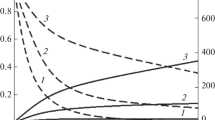Abstract
A good resolution of four components of aflatoxins was accomplished by using the dry column chromatography method. The decolorization process of interfering substances, by 0.01 N KOH and defatting the extract with petroleum ether yields a clean residue for DCC separation. It is clear that the dry column chromatography is a very simple and time-saving procedure for separation of aflatoxins. DCC columns are more economical than precoated ‘thick layer’ preparative plates and, in DCC, no large developing tanks need to be used. Hazards associated with the use of large volumes of flammable solvents are greatly reduced.
Similar content being viewed by others
References
Abdel-Fattah, H. M., Kamel, Y. Y., Megalla, S. E. & Hafez, A. H., 1982. Aflatoxins and aflatoxicosis I. Fungal flora of some food and animal feeds with special references to aflatoxin-producing abilities. Mycopathologia 77(3): 129–136.
Campbell, A. D. & Funkhower, J. T., 1966. J. Assoc. Offici. Agric. Chem. 49(3): 554–562.
Chen, S. & Fridman, L., 1966. J. Assoc. Offici. Agric. Chem. 49(1): 28–33.
Coomes, T. J., Crowther, P. C., Francis, B. J. & Stevens, L., 1965. Analyst 90: 429–496.
Gimeno, A., 1979. Thin layer Chromatographic determination of aflatoxins, ochratoxins, sterigmatocystin, zearalenone, citrinin, T-2 toxin, diacetoxyscripenol, penicillic acid, patulin, penitrem A. J. Assoc. Offici. Anal. Chem. 62(3): 579–585.
Goldblatt, L. A., 1967. U.S. Department of Agriculture, mycotoxin seminar, Washington D.C., June 16, 1967.
Loev, B. & Snader, K. M., 1965. Chem. Ind. (London) 15.
Loev, B. & Goodman, M. M., 1967. Chem. Ind. (London) 2026.
Mislivec, P. B., Hunter, J. H. & Tuite, J., 1968. Assay for aflatoxin production by the genera Aspergillus and Penicillium. Appl. Microbiol. 16(7): 1053–1055.
Nabeny, J. & Nesbitt, B. F., 1965. A spectrophotometric method for determining the aflatoxins. Analyst 90: 155–160.
Pons, W. A., Cucullu, A. F., Lee, L. S., Robertson, J. A., Franz, A. O. & Goldblatt, L. A., 1966. ibid. 49(3): 554–562.
Shotwell, O. L., Hesseltine, C. W., Stubblefield, R. D. & Sorenson, W. G., 1966. Production of aflatoxin on rice. Appl. Microbiol. 14(3): 425–428.
Stubblefield, R. D., Shotwell, O. L. & Shannon, G. M., 1968. Aflatoxins B-1, B-2, G-1, and G-2: separation and purification. J. Am. Oil Chem. Soc. 45(10): 686–688.
Stubblefield, R. D., Shannon, G. M. & Shotwell, O. L., 1969. Aflatoxins: improved resolution by thin layer. J. Assoc. Anal. Chem. 52(4): 669–672.
Author information
Authors and Affiliations
Rights and permissions
About this article
Cite this article
Megalla, S.E. Rapid, economical qualitative method for separation of aflatoxins B-1, B-2 & G-1, G-2 by dry column chromatography. Mycopathologia 84, 45–47 (1983). https://doi.org/10.1007/BF00436996
Issue Date:
DOI: https://doi.org/10.1007/BF00436996




